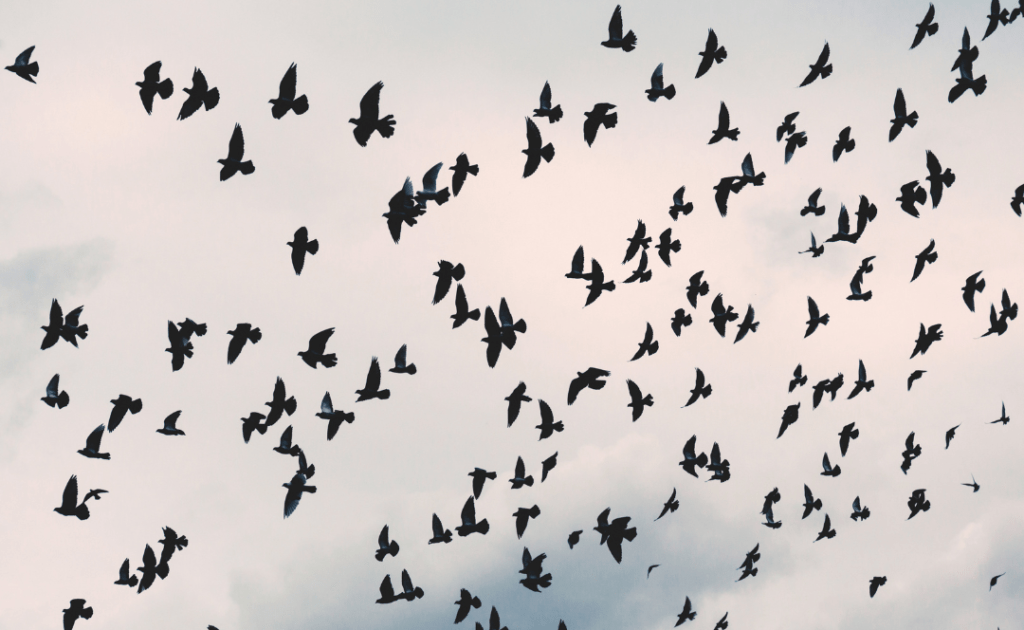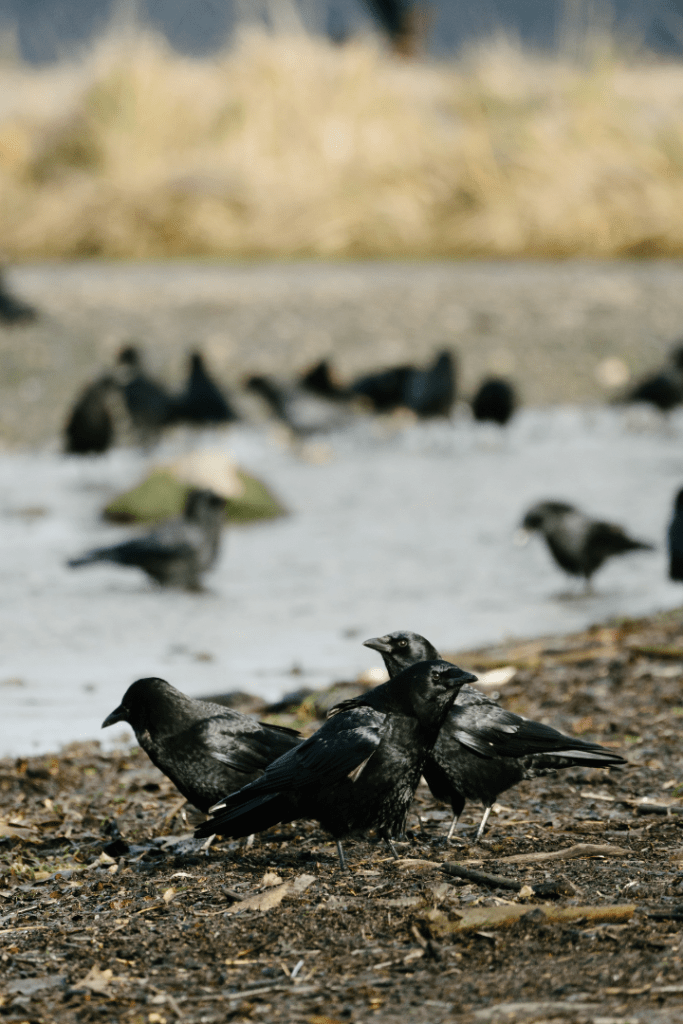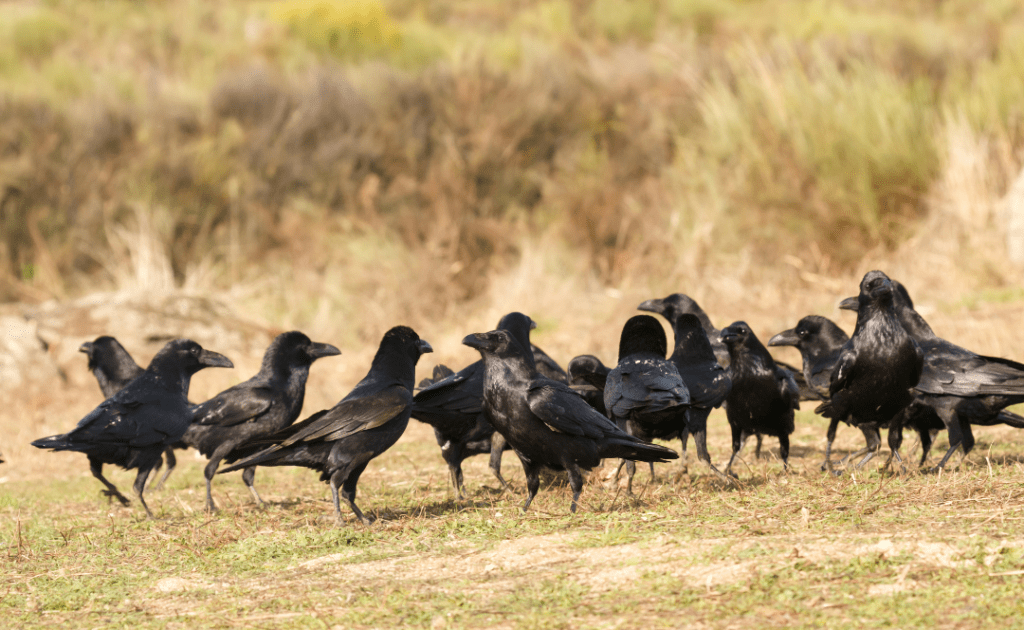Greetings, fellow bird enthusiasts! Welcome back to Happy Birding, the best nook on the web for feathered findings and avian amazements. Today, we are diving deep into the realm of crows, these captivating creatures that offer more than meets the eye.

Crows are fascinating birds that have always intrigued humans with their intelligence and social behavior. One of the most striking behaviors of crows is their tendency to gather in large numbers. These gatherings, known as roosts, can consist of thousands of crows and are a sight to behold. But what prompts these birds to congregate in such large numbers?
Experts believe that crows gather for a variety of reasons. One of the most important reasons is safety in numbers. By gathering in large groups, crows can better protect themselves from predators, such as hawks and owls. Additionally, crows may gather to share information about food sources and to socialize with one another. Before heading to the roost, smaller groups of crows gather in staging areas, where they engage in social activities like grooming and playing.
While the exact reasons for crow gatherings are not fully understood, researchers continue to study these birds to gain insights into their behavior. In this article, we will explore the various reasons why crows gather in large numbers and what these gatherings can tell us about these fascinating birds.
Understanding Crows: A Brief Overview
Crows, Corvus brachyrhynchos, are part of the larger Corvidae family, which also includes jays, ravens, and magpies. They are generally medium to large-sized birds, known for their powerful beaks, strong legs, and impressive cognitive abilities. But what sets crows apart from their corvid cousins is their remarkable social behavior.
The Crow Social Order
Let’s take a peck at the crow’s social structure. Crows, you see, aren’t just social; they’re cooperative breeders. This means that instead of setting off to start their own families, younger crows often stick around their birthplace, helping to raise their younger siblings. It’s a veritable crow commune!
Understanding the dynamics of these crow communities is crucial to getting a grip on their gatherings. There’s a whole social hierarchy at play, from dominant birds down to the rookies. It’s all quite “Game of Thrones”, if you ask me.
Reasons Why Crows Gather in Large Groups
Birds of a feather flock together, as they say. But why do crows gather in such large groups?
Group Safety and Protection
First and foremost, let’s not ignore the obvious. Crows, like most creatures, are all about survival. One of the most effective survival strategies in the animal kingdom? Strength in numbers.
When crows gather in large groups, they’re not just having a social get-together. They’re forming a collective defense mechanism that acts as a powerful deterrent to predators. Predators such as hawks, eagles, or owls might think twice before swooping down on a lone crow. But a large group? That’s an entirely different story. Imagine being a predator faced with dozens, perhaps hundreds, of vigilant crows ready to raise the alarm and mob you in defense of their comrades. It’s akin to trying to rob a bank in broad daylight – not the best idea!

But it’s not just about fending off predators. Gathering in large groups also enables collective foraging. Group foraging is an effective survival strategy that crows have mastered. The more eyes and beaks on the lookout for food, the better. A group of crows can uncover, access, and defend food resources far more efficiently than a solitary bird could. And this cooperation doesn’t just benefit the group as a whole – individual crows also get a better chance at a full belly.
Information Sharing
Crows are known for their intelligence, and their ability to communicate complex information is nothing short of impressive. They can relay details about food sources, threats, and other important events to their peers. You could say that crow gatherings are their version of a community bulletin board.
Through their complex vocalizations, body language, and even tools, crows can share vital information with the group. For example, if a crow finds a substantial food source, it can alert the group, ensuring shared access to this bounty. Similarly, if a crow identifies a threat or danger, it can quickly inform the others, contributing to group safety.
This information exchange isn’t just helpful – it’s crucial for their survival. Research has shown that crows can recognize human faces and communicate this information to other crows. This ability to pass along knowledge helps them avoid dangerous situations in the future.
Social Bonding and Learning Mechanisms
Crows also gather for social purposes, which are as important for them as they are for us humans. These gatherings are not just about survival; they’re also about maintaining and reinforcing social bonds.
Just like us, crows have familial relationships and social hierarchies. In crow gatherings, these relationships are reinforced, and hierarchies are established. Dominant crows might strut their stuff, showing off their status, while younger or lower-ranking crows observe and learn their place in the crow society.
Crow gatherings are also a learning platform, especially for the younger ones. Think of it as a crow’s classroom, where they learn everything from finding food, recognizing danger, to understanding crow etiquette. The adults play a significant role in this, demonstrating and teaching these crucial life skills to the youngsters.
Where do Crows Gather in Large Groups
Seeing a murder of crows is quite a spectacle, and it gets even more impressive when we understand where these crows prefer to gather.
Roosting Sites
One of the most common places to find large crow gatherings is at roosting sites. These sites can range from a small grove of trees to urban areas with tall structures. Roosts provide safety, warmth, and opportunities for social interactions. They also act as information centers where crows exchange details about food and potential dangers.
The interesting thing about crow roosts is that they can host hundreds to thousands, even hundreds of thousands, of crows! And they’re not always in the wilderness; many crow roosts are found in urban or suburban areas. These crows have adapted remarkably well to human landscapes, finding tall buildings or thickly grown trees as suitable places for congregating and nesting.
Feeding Grounds
Feeding grounds are another place where crows often gather in large numbers. These could be agricultural fields, public parks, or landfills. Basically, anywhere with an abundant, easy-to-access food source can attract a multitude of crows. A plowed field, for instance, is like a dinner bell for crows, revealing all sorts of delicious invertebrates and grubs.
During 'Funerals'
Perhaps one of the most intriguing instances of crow gatherings is what many of us refer to as crow ‘funerals’. When a crow dies, others often gather around the deceased, creating quite a spectacle. It’s believed that this behavior might be a learning opportunity, helping crows understand threats in their environment.
Photo of Group of Crows Gathering

Seasonal Gatherings
The number of crows in a gathering can fluctuate throughout the year. During the breeding season, crows often disperse to maintain their individual nesting territories. However, in the non-breeding season (typically in the fall and winter), crows form large communal roosts to share body heat and exchange information.
Crows, Humans, and Cultural Perceptions
From Poe’s raven to Native American mythology, crows hold a significant place in human folklore and culture. They’ve been associated with everything from wisdom and prophecy to omens of death.
Despite these varied cultural narratives, in urban environments, crows are often seen as nuisances. But the more we understand about these complex birds, the more we can appreciate their role in our shared ecosystems.
Frequently Asked Questions
Crow social structure is key to their survival. It ensures safety, enables information sharing, and provides learning opportunities for younger crows.
Crows use their numbers to deter predators and forage for food collectively, which ensures their survival.
Crows use their gatherings to share crucial information, such as food sources or potential dangers, which benefits the entire group.
Social bonding happens through interactions and shared activities. It helps reinforce social hierarchy and provides a platform for younger crows to learn from the experienced ones.
Crow ‘funerals’ are gatherings around a dead crow. Scientists believe this may be a way for crows to learn about threats in their environment.

James has always been an avid outdoorsman. Since a kid, he kept a journal of all the different birds and species he saw. Now he wants to share his passion with other birders with Happy Birding!
